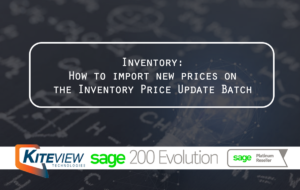Article credit: Sage
Inventory management and stock control are interrelated activities that ensure your stock is effectively organised.
In this article, you’ll learn about the key concepts of stock management and inventory types. You’ll also get guidance on inventory management for small businesses.
What is inventory management?
Inventory, or stock management is a process that ensures you have the right amount of stock, in the right place, at the right time. It involves understanding your customers’ buying patterns and meeting demand, without over- or under-stocking.
Let’s say you run a supermarket chain without an efficient stock management process. You might find that you have more chicken in stock than you can sell. Or not enough rice. This could persuade your customers to go to your competitors instead.
Inventory management is also about planning for fluctuations in demand. For example, ensuring you have extra food available in the run-up to the holidays.
What is inventory control?
Inventory control involves knowing where your goods are at any time. It helps you make the best decisions about how you organise and distribute stock.
Efficient stock control means you can find any product, whenever you need it.
Take our supermarket example again. A good stock control process makes it easier for the store to respond to changes in demand, like selling out of soft drinks during one hot morning. With good grasp of stock control, the store would have sent a driver to get more stock from the warehouse, before the existing stock ran out.
Types of inventory
Different industries have different inventory types. Inventory management is often thought of in relation to retail and manufacturing. But there are various types of inventory that relate to logistics, catering, and even some service organisations.
Here are the main inventory types that your business may need to manage:
- Merchandise
For retailers, merchandise inventory means knowing how much of every product you hold.
- Raw material
Manufacturers should monitor the quantity and value of raw materials they hold.
- Work in process
Manufacturers want to find out how much stock is being processed or assembled.
- Transit inventory
It can take days to move your stock to poorly connected or remote areas. A transit inventory helps you monitor how much of your assets are currently in transit.
- Maintenance, repair, and operations goods
If you offer a repair or maintenance service, an MRO inventory lets you know how much stock you hold.
What is the best inventory valuation model for your business?
Inventory valuation helps you work out the monetary value of the stock you hold. It is also essential for accounting purposes. There are two main types of inventory valuation models: periodic and perpetual valuation.
- Periodic valuation
This is an easier option for smaller businesses or those that sell a limited range of stock. With periodic inventory, goods are recorded as you sell them, but your inventory is not updated. Instead, you do a physical stock count every month, quarter, or year, which you then match up against what you’ve sold.
- Perpetual valuation
Better suited to larger organisations, a perpetual valuation uses inventory management software to automatically update the inventory list after every sale.
What is an inventory management system?
An inventory management system is a comprehensive solution for your business’s stock control and inventory management needs. It makes your processes around stock management more efficient and helps you make better stock decisions.
Many companies use customised inventory management software. This helps them prepare for changing demand based on their specific circumstances.
Kiteview Technologies (Pty) Ltd was founded in May 2010 to provide the Sage Evolution Business Management solution to the SME market. The management team of Kiteview have combined +30 years of experience in the delivery of small to mid-market Financial & Business Management solutions. This experience, combined with a sound project implementation methodology has helped in Kiteview’s growth, becoming a Platinum status partner for SAGE Pastel within just 1 year.
Contact Us
For An Obligation Free Quote








